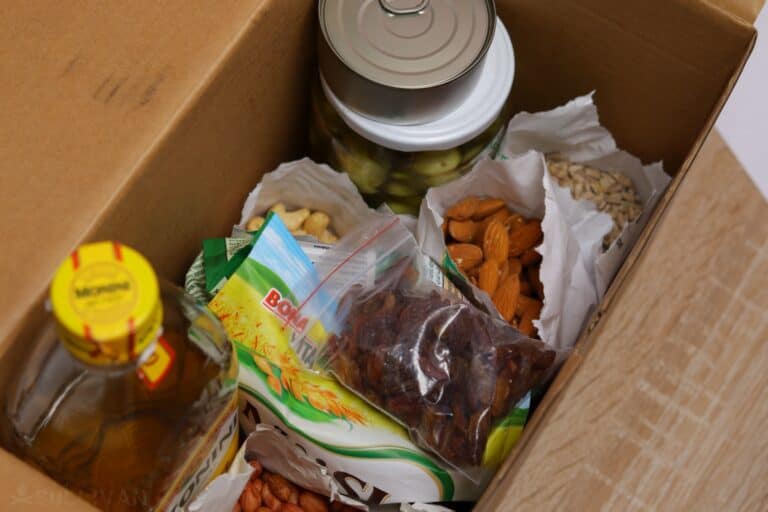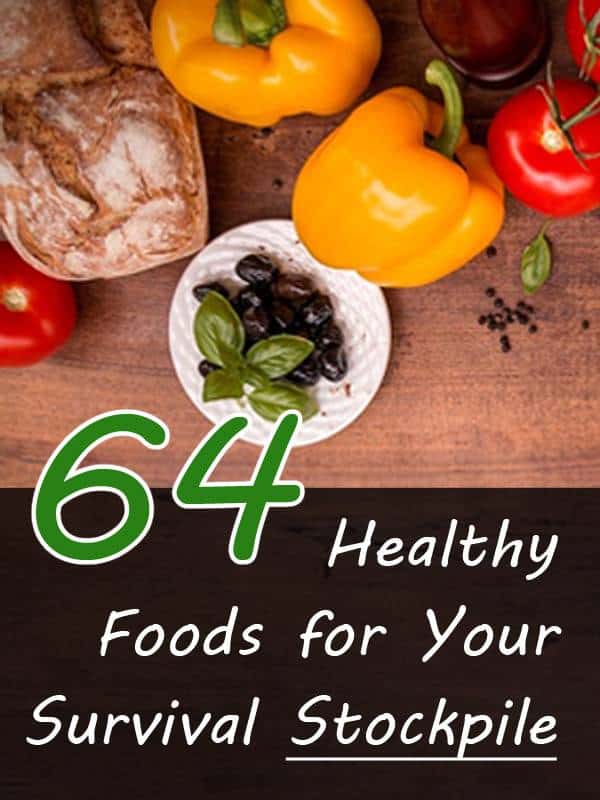Stockpiling food in preparation for a long-term disaster is essential for your survival. But, if you do not stash the right type of food, truly healthy food, the chances of you and your loved ones making it through a SHTF scenario, could be greatly diminished.

The amount of manual labor and stress we all will be enduring throughout a disaster will take its toll on our bodies. Stockpiling long-term storage food and preserving homegrown food that best addresses the enhanced needs of our bodies will help keep us in strong physical and mental condition.
Table of Contents
SHTF Nutrition
Have you stored enough nutritional and healthy food to sustain your family during a disaster? If you have never taken an inventory of EXACTLY what is stacked in your food stockpiles, move that tedious task to the top of your “to do” list.
- Adults need to consume between 10 to 35 percent of their daily calories from protein and 20 to 35 percent from fat.
- Children and teenagers should be eating between 10 to 30 percent of their daily food intake from protein, and 25 to 35 percent from fat.
- Babies and toddlers need to consume approximately 5 to 20 percent of their daily food intake from protein, and 30 to 40 percent from fat.
- Regardless of age, about 45 to 65 percent of everyone’s daily food intake should stem from carbs.
- All but babies should have a 25 gram daily intake of fiber. Babies (1 year old and younger) should have a 19 gram daily fiber intake.
Calories
The amount of calories an individual needs is determined largely by three factors: age, activity level and overall size – height and weight. The number of calories a body needs to function can vary by season as well.
During the summer months when heat induces additional perspiration, more calories and water will both be needed to maintain a healthy and strong body.
- Adults who are rather sedentary, need a minimum of 1,200 calories per day to maintain body weight.
- An adult would have to consume at least 400 calories each day to avoid starvation and/or malnutrition.
- An active adult, during normal times, should be consuming between 1,500 to 2,000 calories each day to remain strong and healthy.
- During a strenuous situation, like a SHTF situation, it is recommended adults have up to a 3,600 daily calorie intake diet.
- Young children should have a 1,500 calorie diets and babies a 1,000 calories a day food intake.
- Stockpiling food that has a high nutritional count but has a low calorie count, but also has a low calorie count can also be beneficial. Pemmican for example, takes up very little storage space, is lightweight, and highly portable.
The List
Good Carbs
- Whole Oats
- Barley
- Tomatoes. The debate over whether or not tomatoes are a fruit or a vegetable may still be raging on, but one fact is set in stone – they are high in essential antioxidants. Lycopene is the antioxidant that gives tomatoes their juicy ripe red color and helps to protect the body from heart disease, inflammation, or worse.
- Quinoa
- Whole Wheat Bread and Pasta
- Spinach
- Broccoli
- Carrots – Not only are carrots an awesome source for vitamin A, they are also packed with essential minerals and other vitamins that will help keep the body strong and healthy.
- Bananas
- Cabbage
- Acorn Squash
- Oranges
- Cherries
- Cauliflower. Add more cauliflower to your preserved food preps to secure a quality source of vitamins B6, C, K, various essential nutrients, as well as both panthothenic and folate acid.
- Buckwheat
- Legumes
- Apples
- Black Beans
- Amaranth
- Berries – especially blueberries
- Sweet Potatoes. This vegetable types is high in vitamins A and B and is also a moderate source of fiber.
- Bananas – In addition to being a go to food for potassium, bananas are also a prime source of fiber, and can be eaten to help curtail diarrhea.
- Rice
- Bell Peppers – All colors of peppers have a high nutritional and mineral count. Add some to your soups, casseroles, and other SHTF entrees for an added vitamin boost.
- Pumpkins – This fall favorite can be used for a lot more than the filling of a delicious Thanksgiving dessert. Pumpkins are a prime source of healthy cabs, fiber, along with vitamins A and C. Do not pitch the pumpkin seeds when you clean them out for cooking, the seeds are yummy too and a great source of fiber as well.
- Spaghetti Squash – Grow and preserve spaghetti squash and use it in place of white pasta noodles that contain very little nutritional value.
- Whole Grain Teff
- Kamut
- Potatoes
Good Fats
- Unsalted mixed nuts: walnuts, pistachios, cashews and almonds, in particular
- Flax Seeds
- Avocados
- Fish Oil
- Salmon
- Sunflower Seed Butter
- Olives
- Dark Chocolate
- Tuna
- Tofu
- Chia Seeds
- Eggs
- Grassfed lean beef
- Grassfed lean pork
- Whole Milk. Milk is both a source for calcium and protein. Some folks are quite surprised when they learn milk makes a great post workout or strenuous activity drink.
- Full-Fat and Greek Yogurt. Greek yogurts boast a high protein county but not all the sugar found in many other varieties of yogurt. Mix some yogurt into a fruit drink, the morning oatmeal, or even in soup recipes, to make the meal more nutritious.
- Parmesan Cheese
Healthy Protein Choices
- Chickpeas – This healthy food is not only a great source for protein, but also has a substantial mineral and fiber count. Chickpeas compounds include zinc, iron, and folate acid.
- Grassfed lean red meat
- Coconut milk
- Cottage cheese
- Eggs
- Salmon
- Guava
- Peas
- Bison
- Tuna
- Turkey
- Chicken
- Peanut Butter
- Beans. All varieties of beans have a high fiber content, and are also great protein sources.
- Tempeh
Long-Term Storage Healthy Food Mainstays
- Granola Bars
- Protein Bars
- Powdered Whole Milk
- Dried Fruit
- Whole Wheat Crackers
- Peanut Butter
- Hard Salami
Stockpiling and Meal Planning
Finding a tool or supply that has multiple uses typically gets our prepper hearts pounding with excitement. Approach healthy food stockpiling and meal planning the same way.
Anytime you can find a single food that fits into more than one healthy choice category, you are saving space, and possibly money if buying, growing, or raising the item in bulk.
Example of a 3 Month Supply for a 4 Person Family
These should last you about 3 months, but keep in that, the bigger the stockpile, the more likely it is some of it will spoil.
- 30 pounds of beef or chicken broth (or bouillon)
- 100 pounds of rice
- 22 pounds of barley
- 6 pounds of green peas
- 6 pounds of chickpeas – garbanzo beans
- 22 pounds of lentils
Nutrition and Cooking
How we cook our food stockpiles can also help or hinder our health and goal of achieving optimal nutritional intake.
Olive oil is a far better choice for cooking or frying because it is low in saturated and mono-unsaturated fats but boasts a high composition of omega threes and sixes.
There are both good carbs and very bad carbs. Review the labels of all food before buying it to add to your stockpiles.
Foods that have a high carb county (both good and bad) are a lot more varied than the types of foods that have a high protein count.
Starches are complex carbs and are usually contained in foods that have both a high fiber and vitamin/minerals content. Fruit and juices made from fruits, are almost always also a high volume source of carbs. During the juicing process, the fruits can lost a lot of valuable vitamins and minerals.
All varieties of milk and dairy products contain carbohydrates and are often identified as lactose on package labels. Milk typically is thought of as a healthy high protein “food” as well.
Some vegetables are high in starches, others are not. Potatoes, zucchini, and corn are valuable sources of good carbs.
Whole grains is a fairly catch all term that is used to describe various cereal grains: rye, rice, barley, quinoa, wheat, and oat grains. Whole grains are are high in both essential minerals and B vitamins, and area quality source of fiber as well.
So, what percentage of foods currently in your stockpiles include healthy items from this list?


Tara Dodrill is a homesteading and survival journalist and author. She lives on a small ranch with her family in Appalachia. She has been both a host and frequent guest on preparedness radio shows. In addition to the publication of her first book, ‘Power Grid Down: How to Prepare, Survive, and Thrive after the Lights go Out’, Dodrill also travels to offer prepping tips and hands-on training and survival camps and expos.

Peanut butter does not store well long term it goes rancid. I keep seeing this in food lists as a long term food item. You will never forget the taste of rancid peanut butter. Now peanut butter powder might be a good choice. The same with Granola Bars with any Chocolate pieces in it they go rancid from the oils. And the same thing any Chocolate covered Protein Bars. Hard Salami and Jerky are good items to store away just be sure to vacuum pack them. And store in a cool dry location and ROTATE.
I agree about the ordinary peanut butter. Didn’t know peanut butter powder existed. After a bit of research I concluded that it’s too expensive for me.
After making a tally of the 3-month supply of food for 4 people, a division showed that each person would get under 7 ounces per day. In my opinion that’s the path to slow starvation. At a minimum I’d suggest doubling the amounts of each type of food.
Need long term storage vitamins on the list.